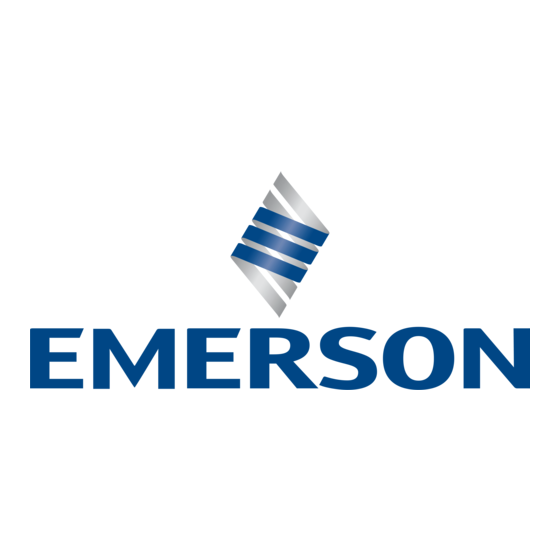Advertisement
Quick Links
Installation Guide
D103120X014
English – June 2023
Introduction
This installation guide provides instructions for
installation, startup and adjustment. To receive a copy
of the instruction manual, contact your local Sales
Office or view a copy at www.emerson.com. For
further information refer to: CS400 Series instruction
manual, D103120X012.
PED/PE(S)R Categories
This product may be used as a pressure accessory
with pressure equipment in the following categories.
It may also be used outside of these Directives using
Sound Engineering Practice (SEP) per table below.
For information on the current PED/PE(S)R revision
see Bulletin: D103053X012.
PRODUCT TYPE
CATEGORIES
CS400
I
CS404
IV
European EN
EN 334,
Reference
EN 14382
Standards
Specifications
Available Configurations
See Table 1
Body Sizes, End Connection Styles and
Pressure Rating
(1)
See Table 2
Maximum Inlet Pressures
Emergency: 12.1 bar / 175 psig
Operating: See Table 3
Operating Pressure Ranges
Regulator: See Table 4
Integral Monitor Module: See Table 5
Slam-shut Module: See Tables 6 and 7
Maximum Outlet Pressures
Emergency (Casing): 1.7 bar / 25 psig
To Avoid Internal Parts Damage:
0.34 bar / 5 psig over set pressure
Operating: 0.38 bar / 5.5 psig
Hydrogen
• Up to 25% Hydrogen Blend (By Volume)
• 100% Hydrogen Construction Available
(Contact Factory)
1. The pressure/temperature limits in this installation guide and any applicable standard or code limitation should not be exceeded.
2. Product has passed Emerson testing for lockup, relief start-to-discharge and reseal down to -40°C / -40°F.
FLUID GROUP
Groups 1 and 2 according to PED
2014/68/EU, 1st and 2nd family gas
according to EN 437 or other gases
(compressed air, nitrogen). The
gas must be non-corrosive, clean
(filtration on inlet side necessary)
and dry.
(1)
(1)
(1)
Operating Temperature (TS)
According to PED Standards:
All Types: -20 to 66°C / -4 to 150°F
Non-PED:
All Types: -29 to 66°C / -20 to 150°F
Installation and Overpressure Protection
▲
Personal injury or system damage
may result if this regulator is installed,
without appropriate overpressure
protection, where service conditions
could exceed the limits given in
the Specifications section and/or
regulator nameplate.
Regulator installations should
be adequately protected from
physical damage.
All vents should be kept open to permit
free flow of gas to the atmosphere.
Protect openings against entrance of
rain, snow, insects or any other foreign
material that may plug the vent or vent
line. On outdoor installations, point the
spring case vent downward to allow
condensate to drain.
This minimizes the possibility of
freezing and of water or other foreign
materials entering the vent and
interfering with proper operation.
For the Type CS403 with the Integral
Monitor or the Type CS404 with slam
shut, point the vents of both the Primary
Regulator and Integral Monitor or slam
shut downward to allow condensate
to drain. From the factory, the Integral
Monitor or slam shut will always point
in the same direction as that of the
Primary Regulator.
Under enclosed conditions or indoors,
escaping gas may accumulate and be
an explosion hazard. In these cases,
the vent should be piped away from the
regulator to the outdoors.
CS400 Series
(1)(2)
WARNING
Advertisement

Summary of Contents for Emerson Fisher CS400 Series
- Page 1 • 100% Hydrogen Construction Available (Contact Factory) 1. The pressure/temperature limits in this installation guide and any applicable standard or code limitation should not be exceeded. 2. Product has passed Emerson testing for lockup, relief start-to-discharge and reseal down to -40°C / -40°F.
-
Page 2: General Installation Instructions
CS400 Series Table 1. Available Configurations TYPE NUMBER OPTIONS OVERPRESSURE PROTECTION MODULE Without Overpressure Protection Module With Integral Monitor Module (1)(3) With Slam-shut Module (2)(3) PRESSURE REGISTRATION External Registration Internal Registration RELIEF Non-Relief Token Internal Relief Internal Relief Example: Type number CS404IT: CS400 regulator constructed with Type VSX4 slam-shut module, with internal pressure registration and with token relief. -
Page 3: Installation Location
CS400 Series Table 3. Inlet Pressure Ratings and Flow and Sizing Coefficients MAXIMUM OPERATING FLOW COEFFICIENTS ORIFICE SIZE IEC SIZING COEFFICIENTS INLET PRESSURE (WIDE OPEN) TYPE psig 3/16 0.97 27.7 0.50 0.91 1.77 28.2 0.50 0.92 CS400, 5/16 2.90 28.3 0.50 0.94 CS403 and... - Page 4 CS400 Series Table 4. Outlet Pressure Ranges OUTLET PRESSURE RANGE SPRING WIRE DIAMETER SPRING FREE LENGTH SPRING TYPE COLOR mbar In. w.c. 9 to 12 3.5 to 5 2.49 0.098 4.18 11 to 16 4.5 to 6.5 Purple 2.03 0.080 4.32 15 to 20 6 to 8...
- Page 5 CS400 Series Table 7. Type CS404 Regulator and Slam-shut OPSO and UPSO Pressure Ranges REGULATOR SLAM-SHUT DEVICE Overpressure Shutoff (OPSO) Underpressure Shutoff (UPSO) Setpoint Spring Range Factory Factory Range Range TYPE Setpoint Setpoint mbar psig mbar psig mbar psig mbar psig mbar psig...
-
Page 6: Parts List
CS400 Series Shutdown Spring Retainer Spring Seat Installation arrangements may vary, but in any Valve Stem installation it is important that the valves be opened or Diaphragm Screw Retainer for Non-Relief closed slowly and that the outlet pressure be vented Adjustable Upper Seat Token Relief before venting inlet pressure to prevent damage Token Restrictor Plate... - Page 7 CS400 Series TORQUE: 1.7 TO 3.4 N•m / 15 TO 30 IN. LBS TORQUE: 1.7 TO 3.4 N•m / 15 TO 30 IN. LBS TORQUE: 47 TO 61 N•m / 35 TO 45 FT-LBS TORQUE: 1.7 TO 3.4 N•m / 15 TO 30 IN.
- Page 8 Emerson Company. The Emerson logo is a trademark and service T +1 800 558 5853 T +65 6777 8211 mark of Emerson Electric Co. All other marks are the property of their +1 972 548 3574 respective owners. The contents of this publication are presented for informational purposes...











Need help?
Do you have a question about the Fisher CS400 Series and is the answer not in the manual?
Questions and answers